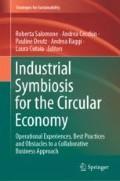Abstract
The optimisation and the resources saving can represent an economic lever and support companies’ competitiveness. In Italy, the national government has established a strong policy for energy saving, energy efficiency and for incentives to energy production from renewable sources, whereas polices and tools for improving resource efficiency have not been developed yet. The purpose of this work is to present an operational methodology, developed by ENEA, for the audit of resources at the company level, with the aim to boost resource efficiency, thus obtaining both economic and environmental advantages. This methodology operates both internally, by means of an efficiency increase and processes optimisation, and externally, by means of the cooperation with other companies and stakeholders at territorial level (industrial symbiosis). The proposed resources audit is based firstly on the analysis of input and output resources used and produced by a company and then on the investigation of possible options to reduce their consumption or under-utilization (waste disposal, etc.).
Access this chapter
Tax calculation will be finalised at checkout
Purchases are for personal use only
References
Ayres RU, Ayres LW (2002) A handbook of industrial ecology. Edward Elgar, Cheltenham
Chertow MR (2000) Industrial symbiosis: literature and taxonomy. Annu Rev Energy Environ 25(1):313–337
Chertow MR (2004) Industrial symbiosis. In: Cleveland CJ (ed) Encyclopedia of energy. Elsevier, San Diego
Chiavetta C, Fantin V, Cascone C (2017) L’Economia Circolare nel settore agroalimentare e il Life Cycle Assessement come strumento a supporto: il progetto FOOD CROSSING DISTRICT. ENEA technical report, USER-PG64-003, June 2017
Cutaia L, Morabito R (2012) Sostenibilità dei sistemi produttivi. Strumenti e tecnologie verso la green economy. ISBN 978-88-8286-258-9
Cutaia L, Morabito R, Barberio G, Mancuso E, Brunori C, Spezzano P, Mione A, Mungiguerra C, Li Rosi O, Cappello F (2014) The project for the implementation of the industrial symbiosis platform in sicily: the progress after the first year of operation. In: Pathways to environmental sustainability. Methodologies and experiences, XXIII, ISBN 978-3-319-03825-4 and ISBN 978-3-319-03826-1
Cutaia L, Luciano A, Barberio G, Sbaffoni S, Mancuso E, Scagliarino C, La Monica M (2015) The experience of the first industrial symbiosis platform in Italy. Environ Eng Manage J 14(7):1521–1533
Decreto Legislativo 18 luglio 2016, n. 141 (2016) Disposizioni integrative al decreto legislativo 4 luglio 2014, n. 102, di attuazione della direttiva 2012/27/UE sull’efficienza energetica, che modifica le direttive 2009/125/CE e 2010/30/UE e abroga le direttive 2004/8/CE e 2006/32/CE. (16G00153) (GU Serie Generale n.172 del 25-07-2016)
Desrochers P, Leppälä S (2010) Industrial symbiosis: old wine in recycled bottles? Some perspective from the history of economic and geographical thought. Int Reg Sci Rev 3(3):338–361
Ellen MacArthur Foundation (2012) Towards the circular economy, vol 1: Economic and business rationale for a circular economy. http://www.ellenmacarthurfoundation.org/publications
Ellen MacArthur Foundation (2013) Towards the circular economy, vol 2: Opportunities for the consumer goods sector. http://www.ellenmacarthurfoundation.org/publications
Ellen MacArthur Foundation (2014) Towards the circular economy, vol 3: Accelerating the scale-up across global supply chains. http://www.ellenmacarthurfoundation.org/publications
Ellen MacArthur Foundation (2015) Towards a circular economy: business rationale for an accelerated transition. http://www.ellenmacarthurfoundation.org/publications
ENEA (2017) Linee Guida per il Monitoraggio nel settore industriale per le diagnosi energetiche ex art. 8 del d.lgs. 102/2014
European Commission (2011) Roadmap to a resource efficient Europe, COM/2011/571 final
European Commission (2012) European Resource Efficiency Platform (EREP), Manifesto & Policy Recommendations. http://ec.europa.eu/environment/resource_efficiency/documents/erep_manifesto_and_policy_recommendations_31-03-2014.pdf
European Commission (2015) Action plan for the circular economy, COM/2015/0614 final
European Union (2018) Directive (EU) 2018/851 of the European Parliament and of the Council of 30 May 2018 amending Directive 2008/98/EC on waste (Text with EEA relevance). PE/11/2018/REV/2. OJ L 150, 14.6.2018, pp 109–140
Garner A, Keoleian GA (1995) Industrial ecology: an introduction. In: Pollution prevention and industrial ecology. National Pollution Prevention Center for Higher Education, University of Michigan, Ann Arbor
International Organisation for Standardisation (ISO) (2006a) ISO 14040—Environmental management—life cycle assessment—principles and framework, Geneva, Switzerland
International Organisation for Standardisation (ISO) (2006b) ISO 14044—Environmental management—life cycle assessment—requirements and guidelines, Geneva, Switzerland
Jelinski LW, Graedel TE, Laudise RA, Mccall DW, Patel CKN (1992) Industrial ecology: concepts and approaches. Proc Natl Acad Sci USA 89(3):793–797
Krausmann F, Gingrich S, Eisenmenger N, Erb KH, Haberl H, Fischer-Kowalski M (2009) Growth in global materials use, GDP and population during the 20th century. Ecol Econ 68(1):2696–2705
Lombardi DR, Laybourn P (2012) Redefining industrial symbiosis. J Ind Ecol 16(1):28–37
Luciano A, Barberio G, Mancuso E, Sbaffoni S, La Monica M, Scagliarino C, Cutaia L (2016) Potential improvement of the methodology for industrial symbiosis implementation at regional scale. Waste Biomass Valorization 7(4):1007–1015. https://doi.org/10.1007/s12649-016-9625-y
Mattila T, Lehtoranta S, Sokka L, Melanen M, Nissinen A (2012) Methodological aspects of applying life cycle assessment to industrial symbioses. J Ind Ecol 16:51–60
UN (2015) Department of Economic and Social Affairs Population Division, World Population Prospects the 2015 Revision
UNEP (2011) Decoupling natural resource use and environmental impacts from economic growth. ISBN: 978-92-807-3167-5
UNEP (2012) Annual report 2012. ISBN: 978-92-807-3323-5 DCP/1646/NA
UNEP (2015) The 2030 Agenda for sustainable development of the United Nations Environment Program
Zhang Y, Duan S, Li J, Shao S, Wang W, Zhang S (2017) Life cycle assessment of industrial symbiosis in Songmudao chemical industrial park, Dalian, China. J Clean Prod 158:192–199
Author information
Authors and Affiliations
Corresponding author
Editor information
Editors and Affiliations
Rights and permissions
Copyright information
© 2020 Springer Nature Switzerland AG
About this chapter
Cite this chapter
Cutaia, L., Beltrani, T., Fantin, V., Mancuso, E., Sbaffoni, S., La Monica, M. (2020). Resources Audit as an Effective Tool for the Implementation of Industrial Symbiosis Paths for the Transition Towards Circular Economy. In: Salomone, R., Cecchin, A., Deutz, P., Raggi, A., Cutaia, L. (eds) Industrial Symbiosis for the Circular Economy. Strategies for Sustainability. Springer, Cham. https://doi.org/10.1007/978-3-030-36660-5_3
Download citation
DOI: https://doi.org/10.1007/978-3-030-36660-5_3
Published:
Publisher Name: Springer, Cham
Print ISBN: 978-3-030-36659-9
Online ISBN: 978-3-030-36660-5
eBook Packages: Earth and Environmental ScienceEarth and Environmental Science (R0)

